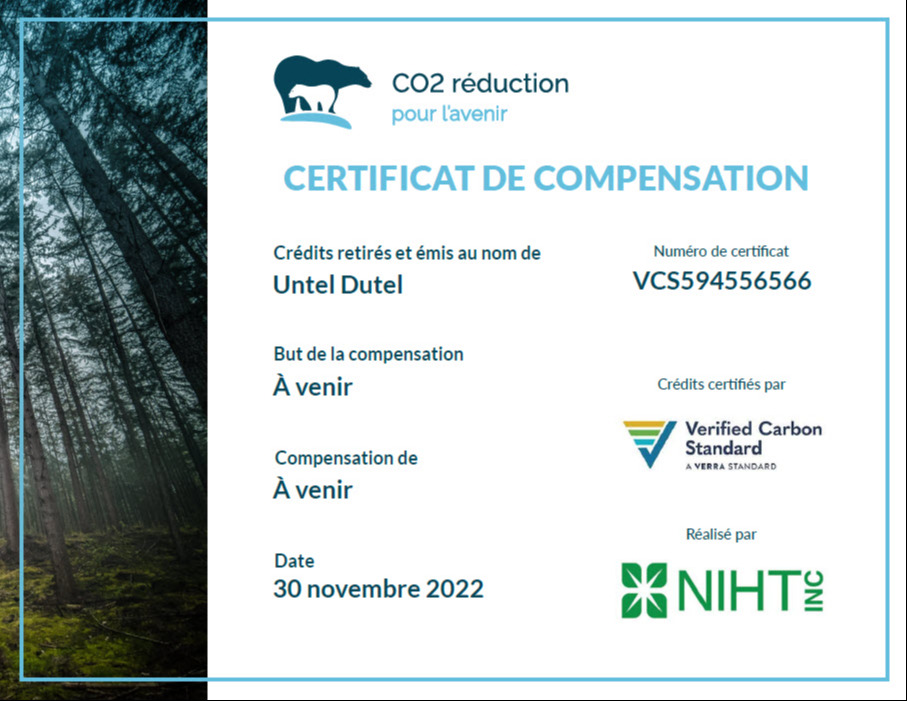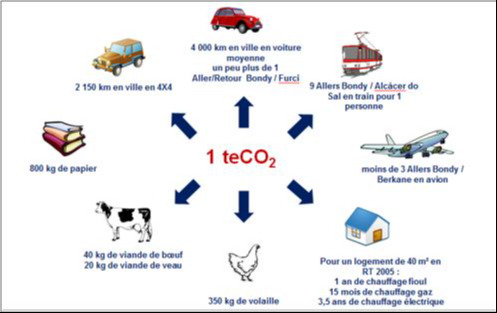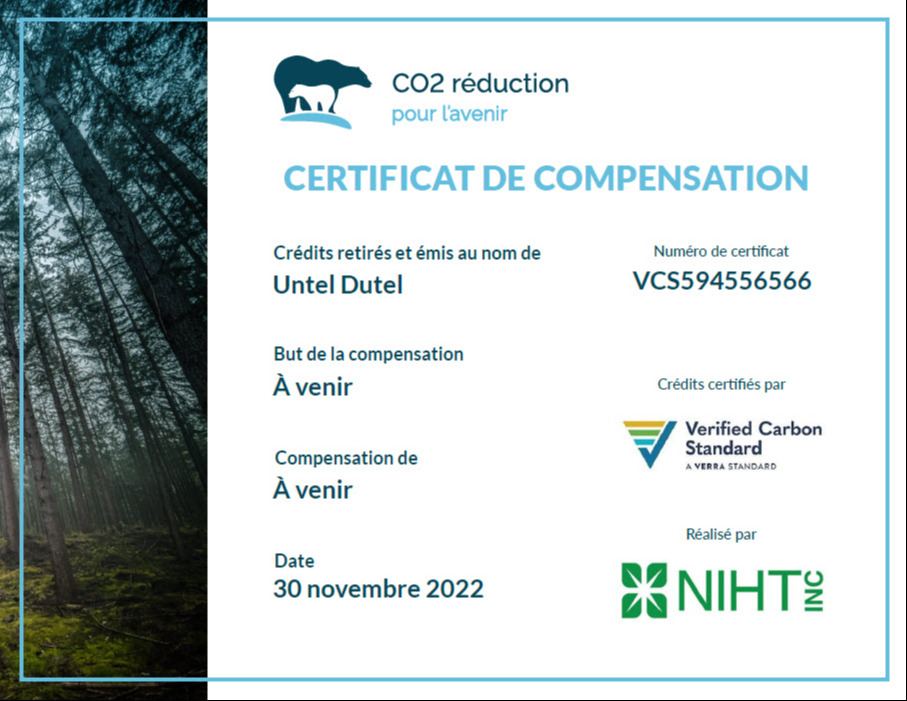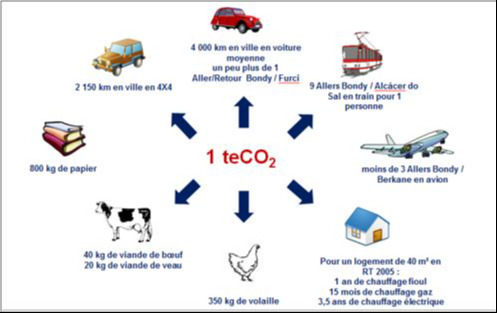Carbon credit
A carbon credit represents a unit of measurement used to assess the reduction of greenhouse gas emissions (GHGs). It is assigned to projects or actions that contribute to reducing these emissions. Each carbon credit is equivalent to one metric ton of carbon dioxide (CO2) avoided or removed from the atmosphere. It is represented by a certificate attesting to this reduction.
1 CARBON CREDIT = 1 METRIC TON OF CO2 (AVOIDED OR SEQUESTERED)
Carbon credit is a key element in the fight against climate change. It is generated by a greenhouse gas (GHG) reduction or avoidance project that has been certified and verified by a third party.
Quality criteria
Serious carbon credits inherent to a project must adhere to strict basic rules according to the chosen certification methodology for the project. Here are the main criteria:
Additionality ; The project would not occur without the revenue from the sale of carbon credits. A project that would happen anyway or is part of the regular activities of organizations is not eligible to generate carbon credits.
Measurability ; The project developer must use a recognized and reliable methodology to calculate the amount of CO2 avoided or sequestered. The public should be able to replicate the calculations proposed by the project by following the methodology used.
Verifiability ; The actual avoidance or sequestration of tons of CO2 related to the project that will be sold as carbon credits must be verifiable and accounted for to ensure that one carbon credit equals one ton of CO2 avoided or sequestered. This verification must be conducted by an independent, competent, and certified third-party organization.
Permanence ; The actual avoidance or sequestration of tons of CO2 related to the project must be permanent over time. Therefore, the avoided or sequestered CO2 must not return to the atmosphere.
Uniqueness ; Carbon credits related to a project must be recorded in a single registry accessible to the public. This is crucial to avoid double counting of carbon credits. When a carbon credit is issued by the methodology, it receives a unique serial number and is deposited into a registry. During a transaction (final sale), it is retired, meaning it can no longer be traded.
Types of carbon projects
Since carbon credits are linked to carbon projects, here are the main types of projects, the most well-known, that generate carbon credits. They are grouped into two categories: CO2 avoidance and CO2 sequestration (or capture).
Avoidance
Renewable Energy Projects; e.g., wind energy, solar panels, hydroelectricity.
Energy Efficiency Projects; e.g., improved combustion stoves, low-CO2 emitting processes, waste management, etc.
Sequestration
Reforestation and Forest Conservation Projects.
Soil and Ocean Sequestration Projects; agricultural, mangrove, and algae.
Industrial Sequestration Projects; CO2 capture by technological equipment.
These criteria are more precisely defined in the various project methodologies (also known as certification protocols). To issue carbon credits from a project, the aforementioned criteria among others must be validated and certified by an internationally recognized organization.
The main certification (standard) bodies are; Gold Standard, VERRA (VCS), CDM
Here is an example of our compensation certificate:

History
The concept of carbon credits originated in the late 1990s with the creation of the Kyoto Protocol, which was the first international treaty on climate change. The protocol aimed to limit the growth of greenhouse gas emissions. It was adopted on December 11, 1997, but only entered into force in 2005, thereby establishing the United Nations Framework Convention on Climate Change (UNFCCC). The protocol included the process of negotiating emission rights, known as carbon credits.
Utility of Carbon Credits
The utility of carbon credits lies in their ability to bridge projects and investors by financing and encouraging emission reduction initiatives. They incentivize individuals and businesses to adopt more sustainable practices and invest in environmental and ecological projects. Additionally, carbon credits promote the development of a green economy by supporting projects such as renewable energy, reforestation, and energy efficiency worldwide. The functioning of carbon credits is based on the principles of participation and compensation. When an entity, whether it's a company or an individual, emits greenhouse gases, they can invest in emission reduction projects. In return, they receive carbon credits, which they can use to offset their own emissions.
It is important to note that carbon credits are an effective means of financing positive environmental actions.
Equivalence
The concept of carbon credits can be challenging to grasp because CO2 is not visible; we only see its impacts on our planet, and the relationship between the two is not instantaneous. We must rely on the thousands of international scientists and their studies, which can no longer be contested.
Here's a simple way to visualize and understand what one ton of CO2 is equivalent to:
Here's an example

Life Cycle of a Carbon Credit
Carbon credits have a long life cycle. They begin with the validation of emission reduction projects, followed by their registration, verification, certification, and finally, the issuance of credits and their registration in the registry. Credits can then be sold on the market, purchased by individuals or businesses, and subsequently retired when the credits are offset against generated CO2 emissions.
Carbon credits are a crucial instrument in the fight against climate change. They incentivize the reduction of greenhouse gas emissions, support environmental projects, and contribute to the creation of a sustainable economy. Understanding their life cycle and utility is essential for anyone wishing to play an active role in protecting our planet.
Frequently Asked Questions
Have any question?
What is a carbon credit and how does it work?
A carbon credit is a unit of measurement used to assess the reduction of greenhouse gas (GHG) emissions. It is awarded to projects or actions that contribute to reducing these emissions.
What are the quality criteria for carbon credits?
Carbon credits must meet strict criteria such as additionality, measurability, verifiability, permanence, and uniqueness to ensure their quality and authenticity.
What types of projects can generate carbon credits?
Projects in renewable energy, energy efficiency, reforestation, carbon sequestration in soils and oceans, and industrial carbon capture are the main types of projects that generate carbon credits.
What are the standards and certifications associated with carbon credits?
Standards such as Gold Standard, VERRA (VCS), and CDM (Clean Development Mechanism) ensure the quality and authenticity of carbon credits by verifying emission reductions.
How does the lifecycle of a carbon credit work?
Carbon credits go through several stages, from project validation to credit production, market sale, and retirement for offsetting CO2 emissions.
What is the utility of carbon credits in combating climate change?
Carbon credits encourage GHG emission reduction, support environmental projects, and contribute to the creation of a sustainable economy.
What is the history and origin of carbon credits?
Carbon credits emerged with the creation of the Kyoto Protocol in the 1990s, aiming to limit the growth of greenhouse gas emissions.
How can you visualize and understand the equivalence of a ton of CO2?
A ton of CO2 can be visualized in terms of environmental impacts such as GHG released from deforestation, fossil fuel combustion, or electricity production.
What are the steps to obtain carbon credits?
The steps include project validation, registration, third-party verification, certification, credit serialization, sale, and utilization.
What are the benefits of carbon credits for businesses and individuals?
Carbon credits allow businesses and individuals to offset their CO2 emissions, support environmental projects, and promote sustainable practices.

